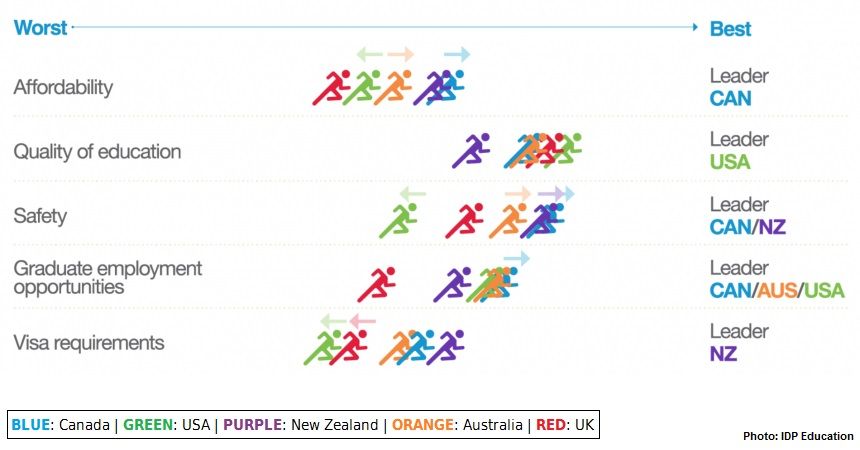PATHWAY: STUDENT GUIDE
MAJOR DIFFERENCES BETWEEN PATHWAY PROGRAMS
Pathway Programs vary according to level of education (i.e. for undergraduate or graduate level studies), the type of academic path they offer (i.e. transition from high school to university, from vocational college to university, or from undergraduate studies at university to graduate studies at university), and the type of courses they provide (only academic, only English language or both).
Some pathways are available in each of the 4 countries (UK, US, Canada, and Australia):
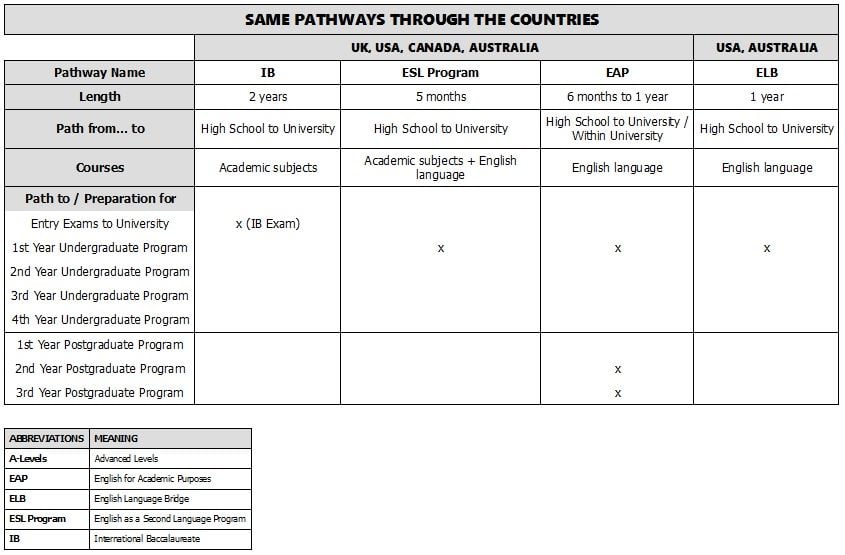
Some pathways are very similar from one country to another, but the name, the length and sometimes the course content may differ. Still, pathway programs can be classified under 3 general pathway headings: Foundation, Bridge, and Graduate Path.
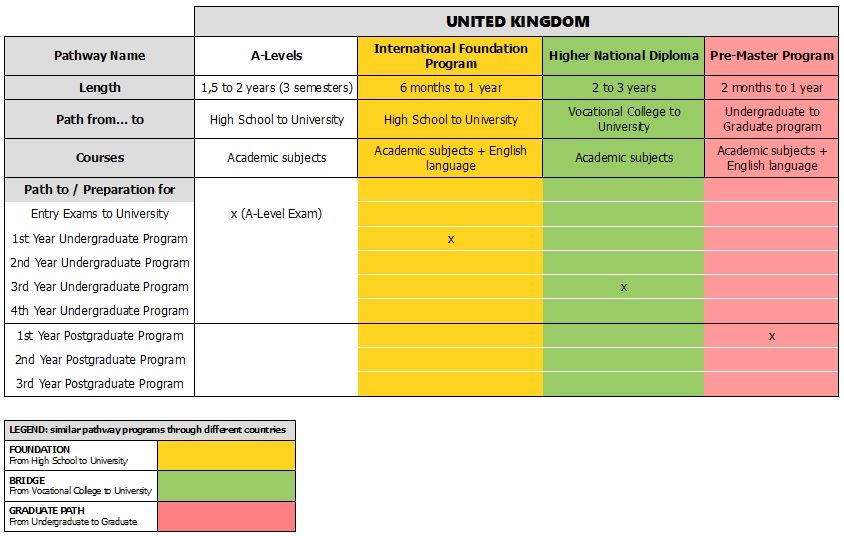

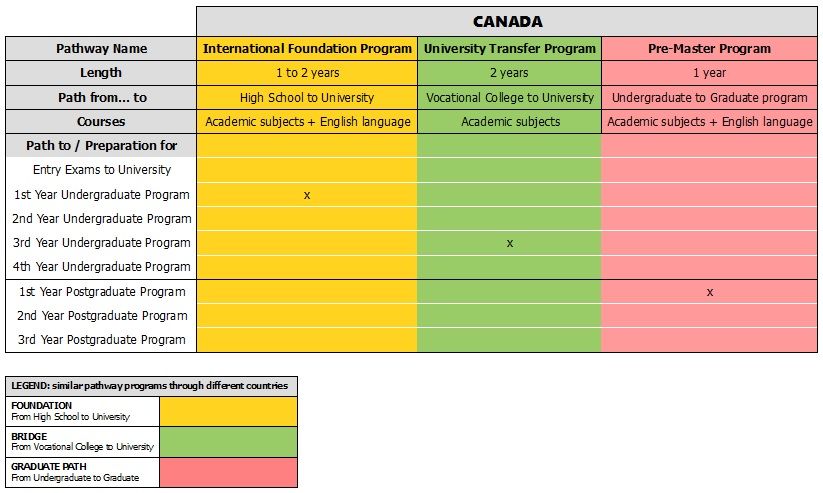
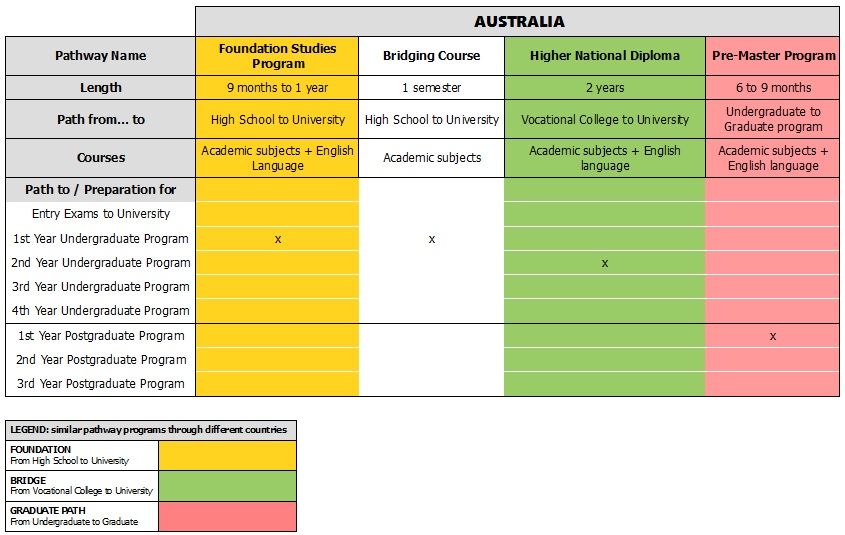
FOUNDATION: Pathways from high school to university (Undergraduate):

- International Foundation Program (UK, Canada)
- Foundation Program (US)
- Foundation Studies Program (Australia)
This program lasts from 6 months to a year in the UK, from 9 months to 1 year in Australia, and it can go from 1 to 2 years in Canada and the US. Successful completion of one of these programs allows students to begin first year undergraduate studies at a university, with the exception of the Foundation Program in the US where students can go directly to the second year of study for a undergraduate program. In all cases, the courses that make up the program are both academic and English language classes.
BRIDGE: Pathways from vocational college to university (Undergraduate):

- Higher National Diploma (HND) (UK)
- University Transfer Program (US, Canada)
- Diploma, Associate Degree (Australia)
Bridge programs cover the gap between vocational college education (very practical courses in direct correspondence with the demands of the working world) and the world of academic education in a university setting. Students first study in a vocational college or vocational university to deepen their knowledge in a specific field before transferring to a general education university to finish their degree.
All aspects of the programs are designed to allow students to go from vocational education to higher academic education. However, while the HND and the University Transfer programs mainly provide academic courses and are a path to enter the third year of an undergraduate program, the Associate Degree in Australia also insists on improving English skills and provides a point of entry to the second year of an undergraduate program. This type of pathway lasts 2 years in the US, Canada and Australia, but can extend to 3 years in the UK.
GRADUATE PATH: Pathways from undergraduate to graduate studies at university (Master):
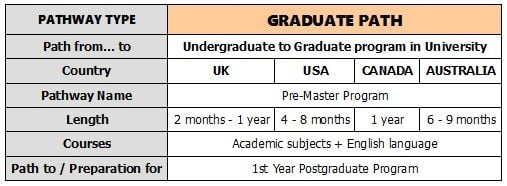
- Pre-Master Program (UK, US, Canada, Australia)
The Pre-Master Program is available in all 4 countries, and in each one it prepares students who have completed an Undergraduate degree in another language and country for their first year of a postgraduate program (Master's Degree). It consists of both academic and English language courses. However, the length varies according to the country: 2 months to 1 year in the UK, 4 to 8 months in the US, 1 year in Canada, 6 to 9 months in Australia.
English Preparation Pathway Programs:
Besides academic pathways, there are programs specifically designed to prepare students for the English level required by universities, such as the ESL Program (English as a Second Language program), the ELB (English Language Bridge), or the English for Academic Purposes program (EAP).
The ESL and ELB programs prepare students for the English level required by universities to enter the first year of an undergraduate program, but the EAP program ensures that students have the level of fluency and mastery of English required for postgraduate study.
ESL Programs offer English language courses to which they progressively add academic subjects in order for the students to improve their knowledge of both, the ELB only focuses on deepening the English level of the students. Also, the ESL Program is shorter (about 5 months) than the ELB (1 year).
WHAT TO LOOK FOR WHEN CHOOSING A PATHWAY PROGRAM
To choose the right pathway program for your needs, you should first compare:
- 1. the university requirements:
- academic requirements (number of years of education that must be completed before applying: generally 12 years of elementary/secondary school, an equivalent of high school diploma or other secondary education certificate to enter an Undergraduate program, and having completed an Undergraduate program to enter a Postgraduate program)
- English level requirements (minimum IELTS score, TOEFL score, or other Equivalent English tests)
If a student doesn't meet the university requirements, they first need to follow a pathway program. However, even pathway programs have academic and language requirements.
- 2. the pathway program requirements:
- English level requirements: (minimum IELTS score, TOEFL score, or other Equivalent English tests). The English level required by pathway programs is generally lower than the one required by a university. If a student does not yet have the required level of English level for their pathway program, they are usually offered general English courses to help them attain it. Once they reach a suitable level they can then enroll in a pathway program.
- academic requirements (number of years of education that must be completed before applying: generally 12 years of elementary/secondary school, and an equivalent of high school diploma or other secondary education certificate to enter an Undergraduate program, or, completion of an Undergraduate program to enter a Postgraduate program)
- minimum age required to take the pathway program
COUNTRY COMPARISON
